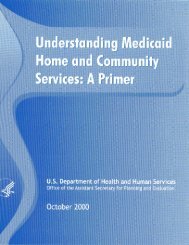Cost-Effectiveness of Home and Community-Based Long-Term Care ...
Cost-Effectiveness of Home and Community-Based Long-Term Care ...
Cost-Effectiveness of Home and Community-Based Long-Term Care ...
Create successful ePaper yourself
Turn your PDF publications into a flip-book with our unique Google optimized e-Paper software.
• In contrast, state coverage <strong>of</strong> other home <strong>and</strong> community-based waiver <strong>and</strong>personal care services is at the discretion <strong>of</strong> the states.• Under home <strong>and</strong> community-based waivers, states may request Health <strong>Care</strong>Financing Administration (HCFA) approval to cover non-pr<strong>of</strong>essional servicessuch as personal care, homemaker/chore services, home-delivered meals, adultday care, habilitation services, or any other services the state believes arealternatives to institutional care for a specified number <strong>of</strong> recipients who areconsidered to be "at risk" <strong>of</strong> requiring institutional care.• Services provided under home <strong>and</strong> community-based services waivers need notbe <strong>of</strong>fered state-wide <strong>and</strong> they may be targeted only to certain populations (e.g.,elderly <strong>and</strong> physically disabled adults, persons with MR/DD, ventilator-dependentchildren, persons with severe mental illness, persons with HIV/AIDs). States mayhave one or more waiver programs targeted at different populations.• Medicaid personal care services may be provided as a optional benefit underthe state plan. This benefit covers only personal care. When personal careservices are provided under the plan as an optional service, as contrasted with awaiver, they must be made available state-wide <strong>and</strong> they must be provided to allMedicaid eligibles who meet need criteria.• States may elect to use either or both <strong>of</strong> these coverage options.How Many States Offer <strong>Home</strong> <strong>and</strong> <strong>Community</strong>-<strong>Based</strong> <strong>Care</strong> <strong>and</strong> HowMuch do They Spend?All states have one or more programs that finance home <strong>and</strong> community-basedservices for individuals with chronic functional disabilities (Ladd et al., 1995; Ladd et al.,1999). The major source <strong>of</strong> financing for these programs is Medicaid. Other fundingsources include Title III <strong>of</strong> the Older Americans Act, the Social Services Block Grant,<strong>and</strong> state appropriations.There are, however, dramatic differences across states <strong>and</strong> by target population(aged/disabled or mentally retarded/developmentally disabled). For example, Oregonspends 45 percent <strong>of</strong> its total long-term care expenditures for the elderly <strong>and</strong> disabledon home <strong>and</strong> community-based services, whereas Tennessee spends 97 percent <strong>of</strong> itselderly <strong>and</strong> disabled long-term care expenditures on nursing homes.Among state Medicaid long-term care programs for persons with MR/DD, 17states spent more than two-thirds <strong>of</strong> expenditures on individuals residing in ICFs/MR,whereas in eight states more than two-thirds <strong>of</strong> Medicaid long-term care expendituresare spent on services in home <strong>and</strong> community-based settings.2
















